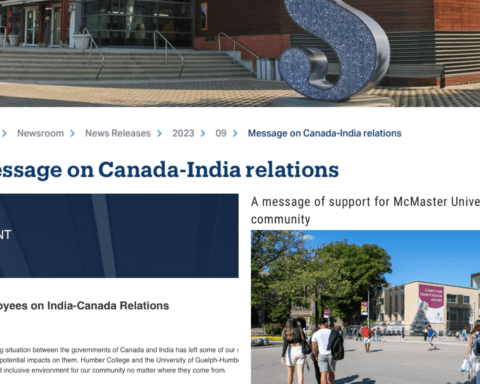The death toll in Nepal’s devastating earthquake crossed 8,000 this week amidst fears that millions of dollars in aid from around the world, including Canada, may be seized by the government.
The Nepalese government’s decision to route earthquake donations through the bank account of the Prime Minister’s Disaster Relief Fund has been a public relations disaster, introducing suspicions about the politicisation of aid even if there is no evidence of foul play, reports said.
The Government of Canada immediately responded to the April 25 quake with a $5-million contribution to provide life-saving assistance through experienced humanitarian organizations. Among the groups of experts sent by more than 30 nations were search and rescue teams, national disaster response units, paramedics, military forces and dog search units.
International aid donors expressed alarm this week after the Nepal government warned that all donations to help its earthquake victims must be made to its Prime Minister’s Disaster Relief Fund, British media reported.
“The Fund seeks to provide a one-window service to the affected people by consolidating amounts, avoiding duplication of effort, and ensuring proportional and equitable access to relief by needy victims in all affected [areas].” – Narayan Gopal Malego, secretary of the Prime Minister’s Disaster Relief Fund
The announcement was seen as an attempt by the ruling Nepal Congress Party to seize control of millions of pounds of aid donations being sent from around the world and raised fears that it could be allocated for political considerations rather than humanitarian need.
A senior UN official, who asked not to be named so he could speak more freely, said that some in the international development community fear that “distribution will be dictated by politicians and patronage.”
Of particular concern is the fact that the government intends to monitor spending through the deployment of officials to electoral constituencies as well as the districts.
“It stinks of politicisation. There’s no logic to it,” the UN official told IRIN.
The Government’s Ruling
The Nepalese government has tried to explain the rationale behind its decision. “The Fund seeks to provide a one-window service to the affected people by consolidating amounts, avoiding duplication of effort, and ensuring proportional and equitable access to relief by needy victims in all affected [areas],” Narayan Gopal Malego, secretary of the Prime Minister’s Disaster Relief Fund, said in a statement on May 2.
“While the government appreciates any and all genuine initiatives to help victims, it also has a duty to regulate the raising of public funds and contribution in the name of disaster, so that benevolent donations are not misused and the rights of victims are protected,” the statement said.
The government is trying to prevent bogus organisations – which emerge in every disaster – from making money off the back of the 25 April earthquake, which killed more than 7,300 people and destroyed or damaged 366,220 homes.
Malego’s statement stressed that the fund “cannot be used to provide donations or any other administrative and overhead costs, including facilities and allowances to civil servants or other office-holders.” It also said the fund would be audited annually by the auditor-general.
Respected Nepali Times editor Kunda Dixit has tried to allay the concerns voiced in the international media. “Firstly, let us be clear: registered NGOs can receive funds from outside the country,” he wrote in a blog on Saturday.
“The government has declared that any funds sent from outside the country to NGOs who were created solely for earthquake relief will be re-routed to the Prime Minister’s Relief Fund. NGOs with existing registrations prior to the earthquake are unaffected by this rule. Funds to these NGOs will not be seized.”
Local “community-based organisations with ties to the affected villages” will be unaffected by the government’s ruling.
“These smaller organisations can leverage even relatively small donations incredibly well because they understand Nepal, are run by Nepalis, and are committed to taking care of their own communities. These organisations need and can utilise quickly small donations provided by the Nepali diaspora and other supporters,” Dixit wrote.
But the government’s decision has raised eyebrows over the potential for misuse of the funds.
Malego’s statement stressed that the fund “cannot be used to provide donations or any other administrative and overhead costs, including facilities and allowances to civil servants or other office-holders.” It also said the fund would be audited annually by the auditor-general.
The government is insisting that the district level is the proper focus for aid distribution, allowing local officials to determine relief priorities based on local knowledge.
Canada’s Part in Relief Efforts
A statement from the Nepal home ministry put the number of injured at 17,866. The April 25 quake, the worst to hit Nepal after 1934, led to widespread destruction across the country.
Kathmandu alone accounts for 1,222 fatalities. Of these, the bodies of 1,200 victims have been handed over to their relatives. The remaining 22 bodies are yet to be identified.
According to the District Disaster Management Committee, a total of 4,634 people were injured in the capital. Of these, 2,862 have returned home after treatment in hospitals.
Canadian disaster teams are also on the ground in Nepal, helping with relief efforts for the thousands of people left injured and homeless.
In addition to the Red Cross, here are some of the other agencies taking donations from Canadians:
- UNICEF Canada is taking donations to help children and their families affected by the earthquake.
- Médecins Sans Frontières — or Doctors Without Borders — is deploying eight medical teams to the affected area.
- World Vision has rescue teams in Nepal with a focus on shelter, education, water, hygiene, distribution of non-food items as well as child protection.
- Save the Children has a focus on helping the most vulnerable children in the affected area.
- OXFAM is on site to ensure people in the affected areas have food and water.
- The World Food Programme is taking donations for people in the affected area.
- The Salvation Army has aid workers en route to Nepal to assist other relief efforts.
- Habitat for Humanity will help people with its expertise in home building and community re-building.
- Canadian Medical Assistance Teams mobilized its assistance team to Nepal. It is accepting money and Aeroplan miles.
- CARE Canada has workers on the ground to help with immediate, life-saving needs.
- Plan Canada is helping children and families affected by the disaster.
- SOS Children’s Villages is on the ground to help unaccompanied and displaced children and their families.
- Samaritan’s Purse has emergency staff and partners on the ground in Nepal.
- The Canadian government has said that it will match donations by Canadians to registered charities doing work in Nepal dollar-for-dollar until May 25.
Published in Partnership with South Asian Post.
The South Asian Post is Canada's premier English language Indo-Canadian newspaper.
The Post specialises in providing South Asian news and views from a Canadian perspective.
A print edition is published in Vancouver, British Columbia on a weekly basis, as well as an e-edition for the Calgary, Edmonton, Winnipeg, Toronto, and Montreal markets. As an Ontario South Asian newspaper, the South Asian Post covers weekly news from metropolitan areas like Toronto, Ottawa, Hamilton, and more.




